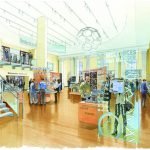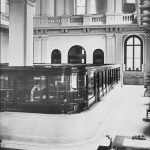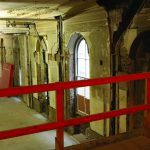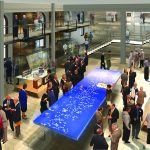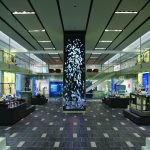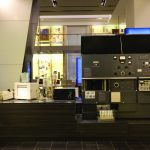Museums theme – Beyond the Black Box: reflections on building a history of chemistry museum
Abstract
https://dx.doi.org/10.15180/170811/001This paper shows how the curatorial team of the Chemical Heritage Foundation (CHF) dealt with institutional tensions in the process of creating a new museum within an existing institution. The initial desire to emphasise narrative evolved into an exhibition that was much more about structuring narratives around artefacts: ‘the two guiding principles were to structure the narratives around the artefacts and to emphasize the social context over the scientific or technical information.’ The importance of determining audience early in an exhibition project and allowing the audience decision to drive content decisions is explored. The paper emphasises, moreover, the need to satisfy several competing interest groups. It was important to maintain an objective distance from the chemical industry, normally assumed to be calling the shots in exhibits such as this, but also not to be so distanced from public expectations as to evoke the well-recalled wrath that had attended the Smithsonian exhibition, Science in American Life. The crisis in museums, as perceived by the team, was therefore an active factor both in provoking an approach to issues of social and technical impact and in warning of the limits.
Keywords
analytical instrumentation, black box, chemistry, content development, design development, exhibit design, exhibition, Museum, museum audience, museum construction
Introduction
https://dx.doi.org/10.15180/In October 2008, the Chemical Heritage Foundation (CHF) opened the doors to its new museum and its first permanent exhibition, Making Modernity. Located in CHF’s headquarters in the historic district of Philadelphia, CHF’s museum encompasses 8,000 square feet of floor space and is divided into two galleries. The smaller gallery, the Clifford C Hach Exhibition Gallery, features temporary exhibitions, while the Masao Horiba Exhibit Hall, which houses the Arnold O Beckman Permanent Gallery and is the focus of this paper, provides approximately 6,000 square feet of exhibition space. The museum is the result of a decade of planning, development, and design by CHF staff, advisors, and a myriad of consultants that culminated in a museum devoted to the history of science and in particular chemistry, a topic underrepresented in museum exhibitions in recent years.
This article will offer an account of the (sometimes challenging) development process of the museum and permanent exhibition from the perspective of the curatorial team.[1] The process by which CHF arrived at design and curatorial choices that were sometimes breaks from the norm for science and technology museums and centres in the United States during the 1990s and 2000s was not easy or straightforward and this case study will provide some insight into the decision-making process that led to some difficult choices. Indeed, throughout the planning process, the curatorial team found itself looking for comparable exhibitions from other museums and repeatedly came up either empty-handed or with examples that curators at those institutions agreed were in need of revision. These discussions with other museum professionals, along with the many meetings of the larger planning group at CHF led to the decision to leave the ‘black box’ unopened in the exhibit, to de-emphasise the technical and scientific, and instead emphasise the social and historical impact of chemistry.
During the museum planning process, several key issues had to be resolved that would have significant impacts on both the exhibition programme and the institution as a whole. Would the exhibition be comprised primarily of fabricated displays and interactive modules that would allow a range of subjects to be discussed, or would it be artefact-focused with the artefacts driving the narrative and content? Would the approach to the exhibition be one of an organisation striving to open a professional museum, or a special events venue with historical elements? Perhaps most challenging for the organisation but most essential to the exhibition process: who would the target audience be? These questions were fundamental ones but were also difficult for a young and growing organisation to grapple with. In the development of any history of science exhibition, these questions must be addressed early in the process if the planning is to proceed smoothly.
A museum of instrumentation
https://dx.doi.org/10.15180/170811/002The Chemical Heritage Foundation began as a private non-profit centre for studying the history of chemistry on the campus of the University of Pennsylvania in 1982. Led by Arnold Thackray from its earliest days, CHF’s leadership had a strong entrepreneurial spirit and by the early 1990s was beginning to grow exponentially in both its activities and its collections. From a centre for historical study it quickly added a special collections and research library, oral history program, and archives. Searching through the institutional archives, the first reference to a plan to develop a CHF museum occurs in 1995 when it was initially conceived of as an instrumentation museum. The museum would be focused on the great analytical instruments that have so dramatically shaped science and the laboratory since 1930 and celebrate the entrepreneurial spirit of the individuals that pioneered the ‘second chemical revolution’ (Ferraro and Brame, 2002).
This early idea was given momentum by a group of retired chemists who were early instrument developers and employees of instrument companies. Their desire to build a museum devoted to instrumentation spurred a boom in the collecting of twentieth-century analytical instruments. It was opportune timing, for few other institutions were interested in collecting modern chemical history and the collection grew rapidly to include nearly six hundred analytical instruments. However, this intensive collecting was not overly systematic or focused, which meant that the collection included many highlights but not a cohesive or overarching theme or story. These early collecting decisions and the rapid growth of the collections would have a significant impact on the later planning of the museum.[2]
As a teaser exhibition, CHF opened Revolutionary Tools in 2002. This display featured instruments from the collections along with several loans and looked chronologically at the ‘electronic revolution’ that occurred in the laboratory post-1930. It took place in a small temporary gallery and had an instrumentation-industry focus with a specific emphasis on Beckman instruments. The exhibition was considered a prototype for the future permanent exhibition; it told a fairly traditional story of breakthrough instruments that made significant impacts on the way the laboratory functioned with some references as to why these developments matter to society as a whole. Unfortunately, CHF was not yet in a position to advertise and market the exhibition so there were few visitors and no formal evaluation process to gather feedback. The visitors that did see the exhibition were primarily CHF’s core constituents (scientists and business executives) and they did respond quite positively.
With Revolutionary Tools as its guidepost, the planning committee developed a proposal to raise supporting funds for the new museum. A 2003 funding proposal describes the core exhibition as the retired chemists that were driving the project initially envisioned it:
At the very heart of the new Museum, both architecturally and programmatically, is the…core exhibition, Molecular Visions… Using interpretive displays of instrumentation in immersive environments as its backbone, Molecular Visions presents the historical sweep of chemical endeavor and its transformative impacts on society… Using innovative interactive devices, evocative settings, and original artifacts, Molecular Visions will inform and inspire the Museum’s audiences.
As can be seen in early architectural renderings, the preliminary design emphasised interactive modules and fabricated exhibitions (see Figure 1). In fact, in the early renderings, open storage sections are one of the few areas where one sees historical artefacts or instruments on display. In addition to the fundamental design questions, the project team had yet to create a clear articulation of the intended audience for the exhibition. Whether a history of chemistry museum or an instrumentation museum, a museum of artefacts or a centre with interactives, a public outreach arm of CHF or a place for scientists and industry professionals to gather and celebrate their heritage, the organisation still needed to resolve the fundamental questions about how it would present the topic and what audience(s) the museum would be trying to reach.

Project MING
https://dx.doi.org/10.15180/170811/003In October 2005, a project-planning consultant, a group of senior staff, historians, and curators at CHF ‘hyper-spaced’ the project from the conceptual to the development phase by conducting a master planning exercise that aimed to develop objectives and goals for CHF’s galleries and conference centre.[3] This meeting resulted in a planning report titled ‘Master Initiative for New Galleries’ and its acronym, MING, became the lasting code word for the project (it referenced the classic Flash Gordon film’s villain, Ming the Merciless). The report was to be a guidepost for the planning of the permanent exhibition, detailing the project scope and how success would be defined. The report articulated the essential ideas and themes that the planning team believed should be a part of the permanent exhibition. The vision provided for the museum and conference centre was expansive: ‘An accessible, thoughtful, and enlightening experience that provides an authoritative and comprehensive view on the historical impact of chemical enterprise on human endeavor and the continuous journey of discovery and innovation. It also offers a window into the diverse and deep resources of CHF and a venue to network and celebrating [sic] achievements and milestones.’ (Matthew, 2005)
While the vision statement was broad, the report also provided a detailed list of project assumptions. While these assumptions appear concrete, in reality they reveal that some fundamental philosophical questions remained unresolved. A look at a selection of the seventeen assumptions listed in the plan is useful for understanding the exhibit development process:
- Exhibits will be based where appropriate on CHF collections.
- Themes and messages will be selected first and then collections resources and methods will be determined.
- There is a direct relationship between innovative display of collections and ability to attract new resources and collections.
- Strive to meet exhibit best-practices for ADA (Americans with Disabilities Act), preventative conservation, and security guidelines within budget.
- Exhibits must be factually correct, aesthetically pleasing, and have WOW factor.
- Core team goes out of existence in 2008 after successful opening and will provide documentation for the organization.
- Primary audience is those who work in the chemical and molecular sciences field (broadly defined) who come to CHF for other purposes such as attending events or to receive awards (e.g., industry leaders and science professionals); secondary audience is curators and educators; third level is educated adults and high school and college classes. Some level of science literacy is always assumed.
- Exhibits and conference space will be integrated thematically and spatially.
- Project will create new ways of interpreting collections and telling stories that reflects CHF’s unique identity.[4]
When reviewing the assumptions it is clear that the primary audience was to remain CHF’s already established core constituency of individuals directly involved in scientific fields, with a scientific-literate public falling a distant third. Despite the articulation of the assumptions, many stakeholders were still unhappy with the defined audience and approach to content for the exhibition. Contemporary professional museum standards stress community needs and impact as the primary drivers in any exhibition planning process.[5] The audience definition was one that would repeatedly cause stumbling points in the planning process – this was largely because time and resources were not taken to assess and collect information from the audiences, whether core constituent or broader public. As Dean writes: ‘An understanding of community needs and expectations comes from audience assessment. A serious and common mistake is basing decisions about exhibition programs on internal assumptions about community needs, rather than on information gathered from the community itself’ (Dean, 1998). This tension between professional museum standards and internal assumptions would be a significant point of contention during the course of planning the museum.
The assumptions also make it clear that themes and narratives were to drive the exhibition content. Because of the rapid and hurried collecting that occurred in the previous decade, the stories were being developed before the curators had fully assessed the collections to identify key artefacts. The 2005 planning document includes three themes and nine stories that were developed in one exhibition planning session. A listing of iconic objects accompanies the stories but very few CHF artefacts are represented. The selected narratives, not the collections at CHF, would drive the exhibition envisioned in the planning report.
Political Semantics
https://dx.doi.org/10.15180/170811/004Any museum professional that tells you that they developed a major exhibition and did not encounter either internal or external politics is either in denial or existing in a vacuum; the development of the museum at CHF was no exception. As alluded to in the discussion of the development of the Exhibit Planning Report, there were politics and definite motivations for developing a permanent exhibition at CHF beyond meeting community needs. All sides proceeded into the planning process with the often-negative public opinion of chemistry and the chemical industry in mind and an awareness that CHF wanted to improve public perception of chemistry without compromising its ‘honest broker’ status. CHF had long fought assumptions from many of its established audience and the general public that the organisation was in ‘the back pocket of industry’. In reality, the organisation’s primary funding sources are private and foundation gifts, not corporations or chemistry organisations.[6] Making sure that the message of CHF as an unbiased producer of historical content was conveyed was an important role and all engaged in the project agreed the permanent exhibition should advance this message.
The planning team was also well aware of the scientific community’s reaction to the Smithsonian’s exhibition Science in American Life a decade earlier as well as the public backlash surrounding the Enola Gay exhibition. Developed at the National Museum of American History in collaboration with, and funded by, the American Chemical Society (the national organisation for chemists that co-founded CHF), Science in American Life was developed as a history exhibition that explored the relationship between science and society. The ACS hoped that ‘the exhibit will be fun, will give visitors an appreciation of the role of science in our society and in our lives, and will demonstrate the need for an informed and scientifically literate public’ (‘Science in American Life Exhibit Opens’, 1994). The scientific community’s (especially physicists) negative reaction to the exhibition and the ensuing fall-out and defence of the curators’ decisions has been well documented (Molella and Stephens, 1996; Hogan, 1996).[7]
The CHF planning team and curatorial staff was cognisant of the reaction to what appeared to be a well-balanced exhibition and how a few vocal opponents could make for ugly public relations. As Art Molella writes: ‘The implications of the controversy over Science in American Life…go far beyond that particular display. The confrontation illustrates the challenges modern national museums face in presenting science and technology to the public. Among those challenges are changing public perceptions of science, scientists’ feelings about those perceptions, and, above all, the symbolic importance science has assumed in the construction of national identity’ (Molella, 1999). The awareness of other exhibitions receiving such negative backlash[8] ran deep enough to make it into the Exhibit Planning Document as a measurable under ‘Other Dimensions of Success: Not fall into Enola Gay exhibit syndrome with no point of view or murky message’ (Matthew, 2005).
These concerns and other political factors led to a perplexing challenge that becomes apparent in the Exhibit Planning Report from 2005 – an aversion had developed to the word ‘museum’. By October 2005, CHF’s museum of instrumentation had quietly evolved to be a conference centre with exhibits. The word ‘museum’ was not used in the Exhibit Planning Report nor CHF’s strategic plan. This, admittedly, left curatorial staff a little confused as to what the purpose and goals of the exhibition would be. In hindsight, defining the new conference centre and exhibit galleries as a museum implied that CHF would be opening its doors to the general public and taking on new programming areas. It was a bit daunting to the organisation to realise that it was developing a project that would fundamentally change the fabric and function of the entire organisation. While the vocabulary would not seem controversial to an institution that started as a museum, for CHF, a public museum had not been a part of the original plan. Exhibitions could still be kept insular; a museum implied an opening of the doors and welcoming of the visitors who walked by CHF on their way to see Independence Hall. Museums had evolved as Weil writes from being ‘oriented primarily inward on the growth, care, study, and display of its collection’ to being ‘an outwardly oriented organization, engaged primarily in providing a range of educational and other services to its visitors [and] its community’ (Weil, 2002). CHF was, understandably, a bit unsure of undertaking such a transformation. After much discussion and a market analysis by an outside firm, it was finally decided to define the new space as a museum and conference centre – this was a key step in the maturation of the project and essential to ensuring that audiences would easily understand what the organisation was about.[9]
Getting to the Molecular Level
https://dx.doi.org/10.15180/170811/005By early 2006, the idea of a permanent gallery space at CHF was becoming a physical reality. The location for the new museum was to be in the original 1865 portion of CHF’s footprint. Designed by well-known Philadelphia architect John McArthur, Jr, the building originally served as the First National Bank. Demolition of the interior first and second floors began while an architectural firm and an exhibition design firm were chosen to develop the plans for the museum and conference centre.[10] The desire was to create both a space that harkened back to the building’s heyday in the late nineteenth century and also evoke a sense of modern design (see Figure 2). The previously renovated reading room on the third floor served as a guide and starting point for the design. Certain classic nineteenth century architectural elements would be restored, including the two-storey arched windows and the Georgian Revival columns. A sense of the modern era was also desired and steel and glass became favourite design elements for both the architects and the exhibition design firm.
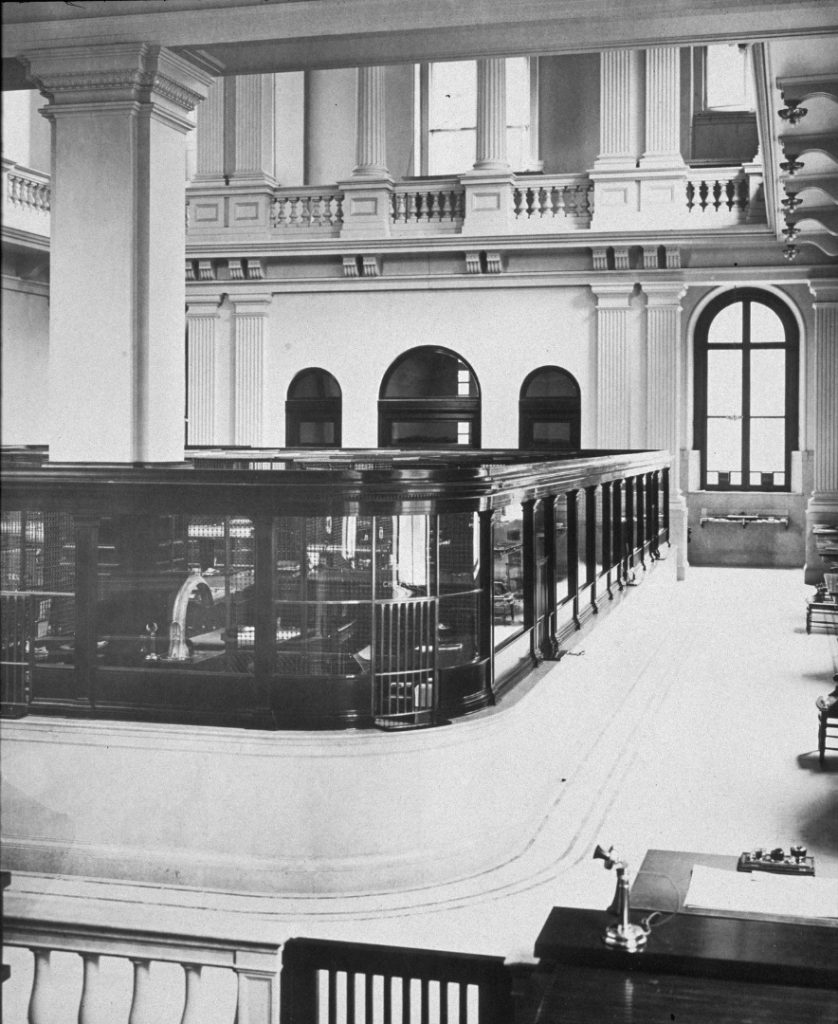
In early 2006, an additional group was formed within CHF that was comprised of CHF’s curatorial and collections management staff and several staff historians. This group, which became known as the curatorial team, was charged with working with the design firm, architects, CHF senior staff, the retired chemists and other experts to develop the storyline, including the content, artefact list, and design.[11] The group would then carry the process through to writing the exhibit text, fabrication, installation, and opening of the new exhibition. The curatorial team would also be the group to fight for the use of the word ‘museum’ and balance the demands of the multiple stakeholders. It was also this group that would educate decision makers about professional museum standards and why exhibition development needed to follow a recognised process.
Moving forward with the content and design development based on the narrative and audience assumptions established in the October 2005 planning report rapidly became a challenge, for the concerns and differing opinions of the various parties involved in the planning quickly revealed themselves. The retired chemists who spearheaded the project in the early phases believed that the museum should be focused on the instrumentation that had played such a crucial role in their own careers and that they had worked so tirelessly to collect. They also were enthusiastic about the idea of a museum that would illuminate for the general public the beauty and excitement of chemistry. The retired chemists were not engaged with an idea of a museum targeted towards an audience much like themselves. The retirees also emphasised the importance of communicating the significance of chemistry and why science (and instrumentation in particular) should matter to a general public. For this group, the rescue of the word ‘chemistry’ from years of bad publicity and negative association was a key role for the exhibition, the museum needed to be, in many ways, a redeemer of the discipline in the public eye. They also felt strongly that technical and scientific information needed to be communicated along with historical facts.
Senior management and fundraising staff had their own strong opinions on what the exhibition spaces should look like and communicate. The conference centre was a major focus of this stakeholder group who saw the potential for an income source as well as a way to encourage CHF’s core constituency of scientists and business professionals in the chemical and molecular sciences to see CHF as a place to discuss contemporary issues. This group liked a ‘hall of fame’ approach and wanted the exhibits to communicate a ‘WOW’ factor. They were also uncomfortable with the idea of ‘permanent’, which implied inflexibility in the exhibition, wanting instead the ability to change exhibition themes to reflect contemporary scientific topics and appeal to potential donors who might visit; this went hand-in-hand with the entrepreneurial spirit of the young organisation. For this group, who were the ultimate decision makers, storyline and narrative took precedence over objects. If CHF had collections to support a storyline, wonderful, but if not, graphics and technology-based substitutes would suffice.
The curatorial team had its own set of assumptions as to how the exhibition should develop. Their preferred targeted audience reflected the team’s professional museum experiences and their ideas were actually similar to the ideas of the retired chemists. The curatorial team argued that the exhibition should capitalise on CHF’s collections since it was the collections that made the organisation unique. The curatorial team believed, like Stephen Weil, that ‘what museums have that is distinctive is objects, and what gives most museums their unique advantage is the awesome power of those objects to trigger an almost infinite diversity of profound experiences among their visitors’ (Weil, 2002). The team also argued that the permanent exhibition should reach a general, scientifically-curious (not just scientifically-literate) public which would be primarily adult but could also reach younger visitors at various entry points. The curators felt that if these audiences were addressed the stakeholders and scientific visitors would also find engaging experiences as well as gratification from experiencing a general public gaining appreciation for their work. The curatorial team did differ from the retired chemists in what the visitor’s take-away should be. The curatorial team believed the exhibition should focus on the history and the social importance of science and technology instead of teaching scientific principles or explaining the technological ‘how’ of the instruments. The team felt that the permanent exhibition at CHF should be about the role of chemistry, and science more broadly, in everyday life. The group was also very aware of the tightrope that needed to be walked in terms of redeeming chemistry from its perceived ‘evil’ association and providing honest, factual, historic assessment and presentation of the artefacts and themes of the exhibition.
Emphasizing the history, de-emphasizing the science
https://dx.doi.org/10.15180/170811/006As the planning moved into schematic design in the summer of 2006, the definitions of audience and scope articulated by the CHF curatorial staff began to prevail. Exhibitions are often about compromise and the building of the CHF museum was no exception – the curatorial team was often the mediator between the stakeholders (including senior management and the retired chemists) and the designers. The exhibition that would take shape over the next two years would be focused around real objects, have a strong narrative focus that was storytelling in style, emphasise the social history of the artefacts, and tell human-themed stories as opposed to the technical ‘how’ and ‘why’. The curatorial team felt this approach was the best method to reach a broader audience of the scientifically-curious. The audience target remained adult – text was written for educated readers but interesting stories and cultural artefacts were included to appeal to a high school (age 14 and older) audience as well. The team also moved beyond ‘chemistry’ in the reach and themes of the storylines. While our collections were of objects primarily chemical in nature, the curators began to think in bigger ‘history of science’ terms wherever possible. This was not in avoidance of the ‘c’ word but in recognition of the historically interdisciplinary relationships of the sciences and even more recently, the blurring of disciplines into new fields such as biochemistry, quantum chemistry, and genetics. The museum’s primary objective is to encourage visitors to want to learn more about how science, especially chemistry, intersects with and matters to their everyday lives. The organisation also chose to not specifically call out the nuances of pure chemistry, industrial chemistry and technology in the larger themes of the exhibition. Instead, these distinct topics, that appear far more blurred to the general public than the practitioner or historian, are intertwined and connected throughout the exhibition’s storylines. Industrial R&D, academic discipline, and pure and applied science are all present but the exhibits do not dwell on the tensions or differences that exist historically in these different realms of chemistry.
Once an audience definition was established and a path was set for a narrative-based exhibition that centred on the artefacts, it was time to start the detailed planning of what would be the visual and interpretive identity of the permanent exhibition. This was particularly challenging because there was only a shell of a space in which to visualise what the museum would finally look like (see Figure 3). Trying to set up mock-up cases or work within the gallery was not an option since the space would be a construction zone until about four months before the opening date. In addition, all the casework was designed to be organic with the architecture so the option of working with cases off-site was not possible. All of the design and layout had to be done via computer-aided design (CAD) in meetings with the design team. This method created additional challenges because considerable time had to be spent measuring, weighing, and describing artefacts so that each artefact could be accurately rendered digitally – there was little forgiveness in the design that would allow last minute on-site tweaking so everything had to be accurate as it was being laid out in the CAD drawings.
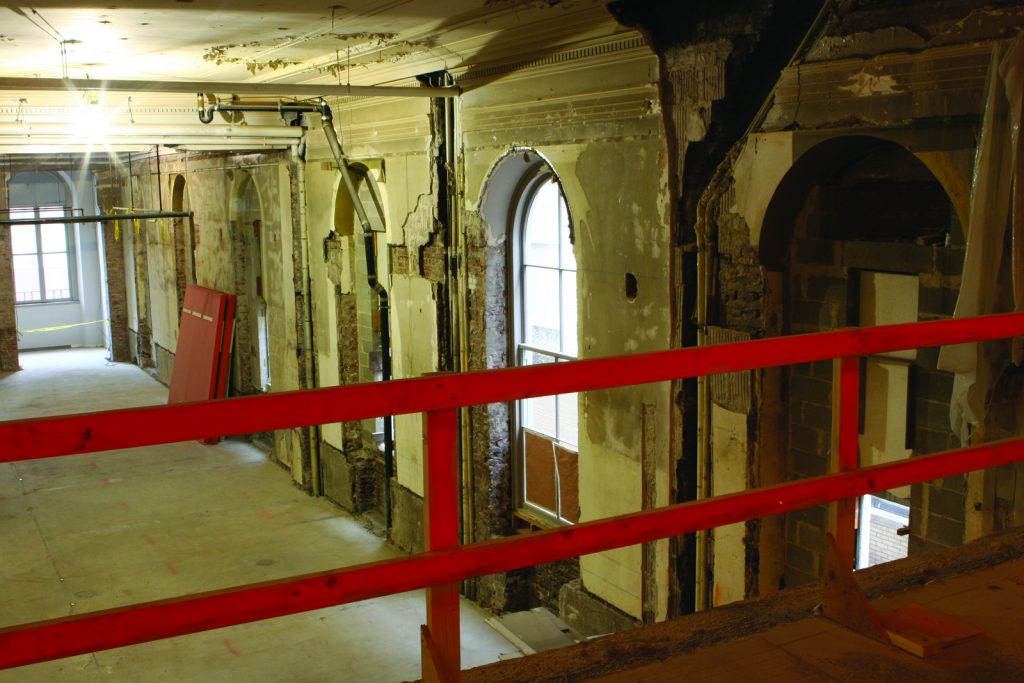
There were also differing opinions on what narratives should be told in the museum and how they should be presented. From the nine themes presented in the October 2005 planning report, the curatorial team and design team tried to identify key objects that could serve as exhibition anchors which the narratives could be structured around. Every curator and historian had his or her own ideas of what were the essential narratives and objects. At one point, there was a working list of over fifty narratives that were then grouped, prioritised, and aligned with listings of CHF collections or potential loans that could best be used to shape the story.
The designers had their own ideas as to how the exhibition should be structured. RAA is a firm that designs exhibitions that are heavily intertwined with the architecture and they worked closely with the architects throughout the project. The desire to connect with the architecture eventually led to the physical layout of the gallery – the placement of the arched windows dictated where the wall cases would be situated, and the need to pinpoint specific floor locations to install load-bearing capabilities to handle the larger instruments determined where the freestanding cases would be.
RAA is also a design firm that likes to be heavily involved in the actual content development and finding ways for the exhibition space to metaphorically communicate a message related to the museum’s content. Early in the planning, the idea was proposed by RAA that there be three concentric layers of content based on a motif of ‘People – Tools – Impacts’.
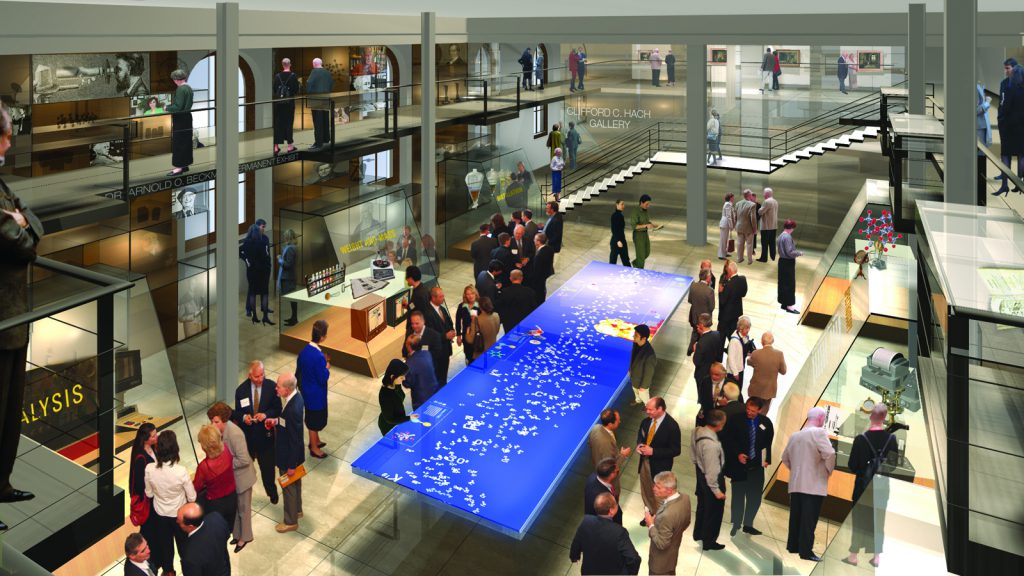
RAA’s idea was that ‘moving from the Gallery’s perimeter to its core, visitors encounter compelling stories of people (individuals and groups), tools and processes, and the impacts of the chemical and molecular sciences on our everyday lives’ (Ralph Appelbaum and Associates, 2006). The curatorial team countered RAA on this, however, arguing that science is far from linear and in reality could be quite chaotic and that the content could not be split so decisively between the three areas – science was about give and take and was rarely unidirectional. RAA went back to the drawing board and the process continued through multiple iterations. Another design proposal based the gallery on the periodic table with the table literally set in the middle of the room as a banquet would be. While a central part of what visitors associate with chemistry, the retired chemists pointed out, quite correctly, that the periodic table itself was only a small part of what defines the field. The periodic table would take a prominent position in the permanent exhibition as the one multimedia component – a column of eighteen high-definition screens play a continual display of the elements – but the periodic table would not become the guiding thematic element.
In designing a museum and permanent exhibit there are milestones and review processes that need to occur. The process for the building of the museum at CHF typically went as follows: 1) the curatorial team and historians would develop several thematic ideas and a list of must-have objects; 2) the team would meet with the designers; 3) the designers would return with some design and content organisation ideas; 4) the curatorial team would provide feedback and bring management on-board; 5) an all-day milestone meeting with stakeholders, including CHF’s president, would be held; 6) the designers would be sent back to the drawing board; 7) repeat.
This push, pull, and re-evaluate cycle continued through 2007; it caused project delays and frustration among many team members and the design firm. Then, in late 2007, a presidential transition occurred at CHF and the curatorial team was allowed to move forward with the designers largely unimpeded. This unforeseen shift fundamentally changed how the exhibition developed and moved on to final text and design.
The permanent exhibition that opened in October 2008 has 24 ‘exhibits’ with nine thematic arcs that are communicated to the visitor through several layers of narrative and artefacts.
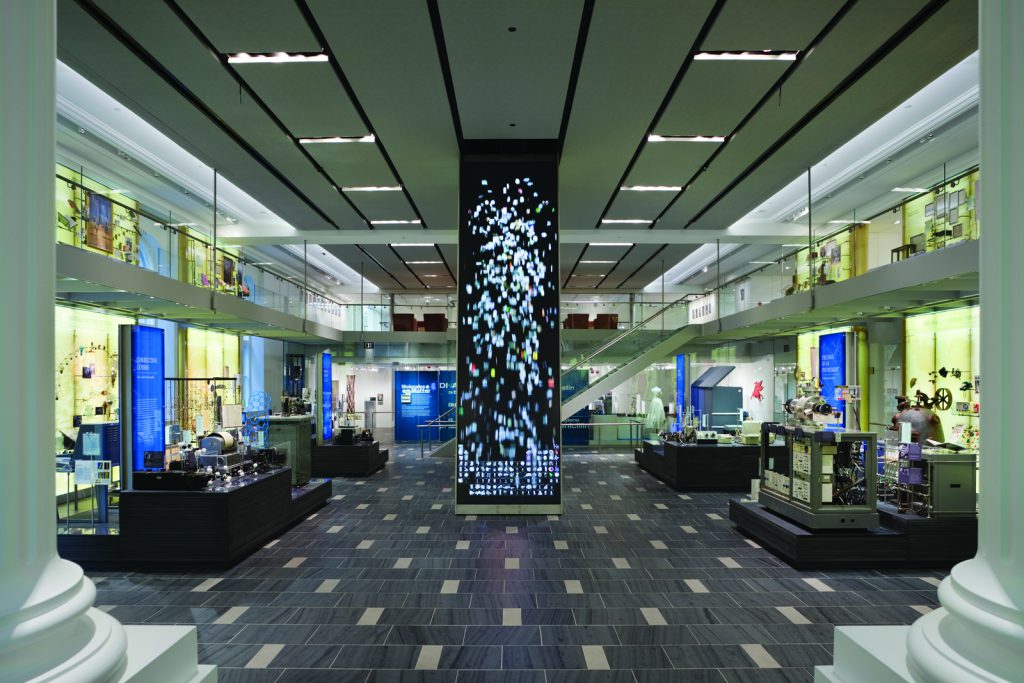
The exhibition includes many different kinds of artefacts from the collections: instruments, glassware, material culture artefacts, fine art, rare books, manuscripts and photographs are all featured in the exhibition. The decision not to follow a chronology or single storyline for the entire exhibition evolved for two reasons. First, as previously mentioned, the arched two-storey windows determined where the casework would go along the walls. The west wall of the museum includes four of the arched windows. To create symmetry with the west wall, the east wall design included four sets of double glass doors that created multiple points of entry for visitors, thus making a starting point and way-finding for the exhibition problematic. Second, there was a desire to communicate to the visitor that chemistry is a human endeavour that is not linear or neat (‘Eureka!’ moments rarely happen) but is usually messy and surprising. After the opening, other advantages were discovered to telling more succinct narratives – the shorter sections seem to hold visitors’ attention longer, visitors spend between 45 minutes and two hours in a 6,000-square-foot exhibition, far longer than was anticipated. Visitors also appreciated the ability to pick and choose what they wanted to focus on – if they only had a half-hour to visit they did not feel as though they had to quickly see everything but could graze topics of interest and come back another time to see other sections.
The genuine artefact
https://dx.doi.org/10.15180/170811/007It is perhaps useful to delve into some specific exhibition narratives and design development examples to demonstrate how the two key principles guided the creation of Making Modernity. As previously mentioned, the two guiding principles were to structure the narratives around the artefacts and to emphasise the social context over the scientific or technical information.
The museum would include only fabricated exhibition components when absolutely necessary and would not include large graphic panels that are widely found in contemporary science centres. This decision had a significant impact on the development of content. Because the narratives needed to be tied to artefacts, there were important subjects that we simply could not include because the objects were not available. For instance, CHF as an institution strives to be international and not just focused on the United States. As the curatorial team sorted and refined the theme and narrative lists we kept returning to the subject of non-western science and the deep roots chemistry has in Eastern and Middle Eastern cultures. Everyone involved in the planning agreed that this was a critical narrative; however, CHF came fairly late to the collecting world and lacks significant collections of antiquities, especially non-western. In the end, despite its importance, the narrative was cut because it could not be an artefact-based story. The absence is acknowledged and a brief glimpse into the deep past of chemistry as a world-wide endeavour is provided in a special introductory case designed to display older and more fragile materials and through a program on the interactive screen in the centre of the gallery.
Just like the acknowledgment of the deep past of chemistry, CHF also did not completely ignore the importance of the discovery of the structure of DNA and the resulting developments in biochemistry. We took the knowledge that we were not highlighting a key story in the history of twentieth-century science and looked for ways to tie the bigger story into a narrative that we could tell in an engaging way with the artefacts in the collection. So in the end we did tell a molecular story with tie-ins to DNA. In the exhibition section titled ‘Under the Skin’ the introductory text reads, in part:
What goes on beneath the skin? What hidden processes cause disease? What is the best way to intervene? Medical thinkers have long grappled with these questions, looking to the visible products of the diseased body… In these investigations blood has held a special place. It is both the carrier of the life force and a complex fluid transporting specific molecules throughout the body.
The story is anchored by two very different artefacts – a selection of lancets and a bleeding bowl tell an early story of the understanding of humours while a Spinco Model E ultracentrifuge serves as the key artefact in the story of studying proteins and genetics to better understand disease (see Figure 6). Knowing that there are only a few remaining Model Es in existence, and given the essential role the instrument played in studying large biological molecules, the curatorial team felt that it was an important object to showcase and it allowed a nod to the ‘discovery of DNA story’ without actually telling it.
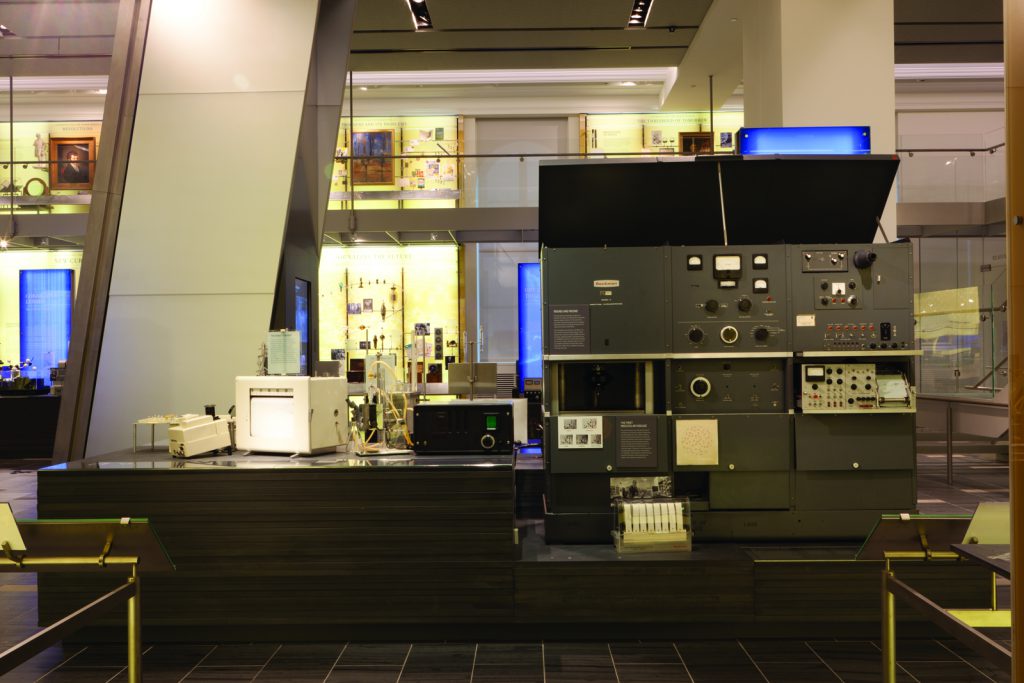
This decision to use only real objects to drive our stories was not an easy one to accept for the CHF management, the retired chemists, the historians who worked with us on content, or the designers. It is understandable: the decision to not tell the story of the discovery of the structure of DNA, a story CHF likes to argue is a chemistry story, was hard to come to terms with. The fact that the narratives would be predominately about the western world, particularly the United States, was also difficult. But this decision reflects CHF’s collecting strengths and the desire to tell only those narratives that could be based on a rich and engaging selection of artefacts. The fact that there are no artefacts in CHF’s collections that could adequately tell the DNA discovery story or the importance of early Arabic science was what drove the decision not to devote text and display space to those stories that were much better told in museums that had the genuine article.
Keeping the black box closed
https://dx.doi.org/10.15180/170811/008The display of the Model E in the museum also serves as an example of the second guiding principle that CHF followed for the development of content and design: the museum would have a strong narrative (storytelling) focus that emphasised human stories and social context with interesting historical, science, or technology facts added as appropriate. Technical descriptions of how the instrument worked or details about great scientific breakthroughs were not included. With the Model E, we knew visitors would be drawn to it because of its large size, and while we provide some interesting facts about revolutions per minute, the overall tone is conversational, as is most of the text in the museum:
Early high-speed centrifuges gave researchers a powerful new analytic tool, allowing them to physically separate samples by density. Yet this power had a price: these custom-built machines had to be operated behind heavy wood or concrete barriers because their rapidly spinning rotors could explode.
These challenges were overcome in the Model E, the first successful commercial ultracentrifuge. Its finely balanced rotor could spin as high as 60,000 revolutions per minute, subjecting samples to gravitational forces up to 289,000 g (by contrast, a roller coaster can briefly hit 5 g). And it could be operated for days at a time: in one of Matthew Meselson and Frank Stahl’s famous experiments on DNA, they ran a Model E continuously for an epic seven days.
We strove to make the exhibition text and interpretation accessible with quotes from oral histories and primary sources as well as anecdotes that might catch visitors’ interest. However, it is important to note that our decision to highlight the social over the scientific or technological should not be perceived as succumbing to the dreaded ‘dumbing down’ that the adult visitor often finds in science centres today. The curatorial team felt that CHF had an enormous opportunity by not having to write our label text for a middle-school or younger age group. The labels and captions explore complex ideas and create layered, visually rich displays of objects, art, books, archival materials, and material culture throughout the gallery that challenge the visitor to think about chemistry’s past and its impact on the modern world in new ways.
In some instances we chose to establish a mood or personal connection. For example, we discussed how scientists feel about the tools they use every day rather than specific informative content such as a chronology of how analytic instrumentation developed. We privileged historical and social context over discussions of function, technology or how something actually works. The curatorial team felt strongly about giving visitors a sense of the social environment of science and the laboratory and the fact that it is not just the lead scientist making the advances. In the exhibition section ‘The Soul of an Instrument’, the introductory text reveals a part of this social context: ‘Used day after day, tinkered with, fought with, present for a lab worker’s greatest triumphs and most dire failures, laboratory instruments can take on a life of their own.’
Non-scientific artefacts help provide connections to everyday material culture without being a derivative of, for instance, the widely seen advertising campaigns of the 2000s by the American Chemistry Council that focus on dramatic, lifesaving innovations such as the plastic in neonatal incubators. In a case devoted to the development of synthetic dyes and the science of colour that includes two colorimeters and parts to a GE Hardy Recording Spectrophotometer, we also include items of beauty and consumer use such as a Germantown Navajo Rug that used synthetically-dyed yarn and a 1941 Putnam dye booklet that promotes at-home dying. This approach also gave an opportunity to challenge visitors’ assumptions and perceptions of chemistry. By placing chemistry themes in social context, the exhibition surprises many by pointing out the multitude of places that chemistry appears in daily life – both positive and negative.
Avoiding ‘hushed halls of didactic strenuousness’
https://dx.doi.org/10.15180/170811/009As the narratives began to develop with the two key principles as guideposts, it became apparent that we also needed to avoid becoming a shrine to great scientific moments, a hall of fame to chemists and the industry, or to quote the lead designer on the project, we needed to avoid becoming a “hushed hall of didactic strenuousness”. This was not always an easy task but CHF felt that it was critical that the museum be an engaging exploration of science as a human endeavour. The visitor will encounter Joseph Priestley, Robert Boyle, Louis Pasteur and other well-known illustrious figures in various narratives in the gallery; however, these ‘great men of progress’ are all presented as participants in a larger historical context.
During the design phase, a unique narrative-based design element was added that CHF called ‘people stories’. These are distinct label panels that tell short stories about individuals or groups and key them to a photograph. But, we purposefully kept our choices for these stories somewhat eclectic, featuring a variety of people and not just scientists. For example, there is the anonymous group of instrument salesmen selling the latest line of Beckman instruments at a tradeshow, Dorothy Nickerson who began as a secretary at the Munsell Color Company and worked her way up through the company and became known as the ‘prophetess of color’, and even Richard Nixon and Ralph Nader who appear as key figures in passing environmental legislation that was influenced by Rachel Carson’s environmental work and her book, Silent Spring.
The good, the bad and the unmentionable
https://dx.doi.org/10.15180/170811/010As one could easily conclude from this review of the development of Making Modernity, the general approach to the history of chemistry in CHF’s museum is a positive one. Part of what makes the organisation unique is the ability to present an objective but affirmative view of chemistry’s impact on society. Public opinion about chemistry in the United States tends to be negative (often with just cause) but part of CHF’s mission is to present the advances that chemistry has offered. The backlash from the scientific community to Science in American Life was also present in the minds of the curatorial team. However, in the museum, objectivity was crucial and it was felt that it was vital to include sections on the negative impact that advances in science can sometimes have. There are several places where we raise the question of unintended consequences and how chemists are looking for solutions to problems that humans have brought about. For example, a case titled ‘One in a Trillion’ looks at environmental issues such as pollution and climate change but instead of dwelling on the problem, the case looks at how instrumentation has enabled chemists to detect smaller and smaller amounts of contaminants and how knowledge of contamination and its impact has helped spur action and solutions.
Many of the negative mentions of chemistry’s impact are notably subtle, they are mere first-forays into controversial topics that can be further discussed in tours (and perhaps more robustly addressed in future iterations of the permanent exhibition); however, the curatorial team also felt that it was important to use some of the museum’s real estate to address the issue head-on. This occurs in the section titled ‘Chemists and the Wider World’, a series of six exhibit cases that present ‘snapshots in time’ and use a piece of fine art to anchor each case. The fifth case in the series focuses on a painting that was commissioned by Dow Chemical Company in the 1920s that features caustic pot house smokestacks.
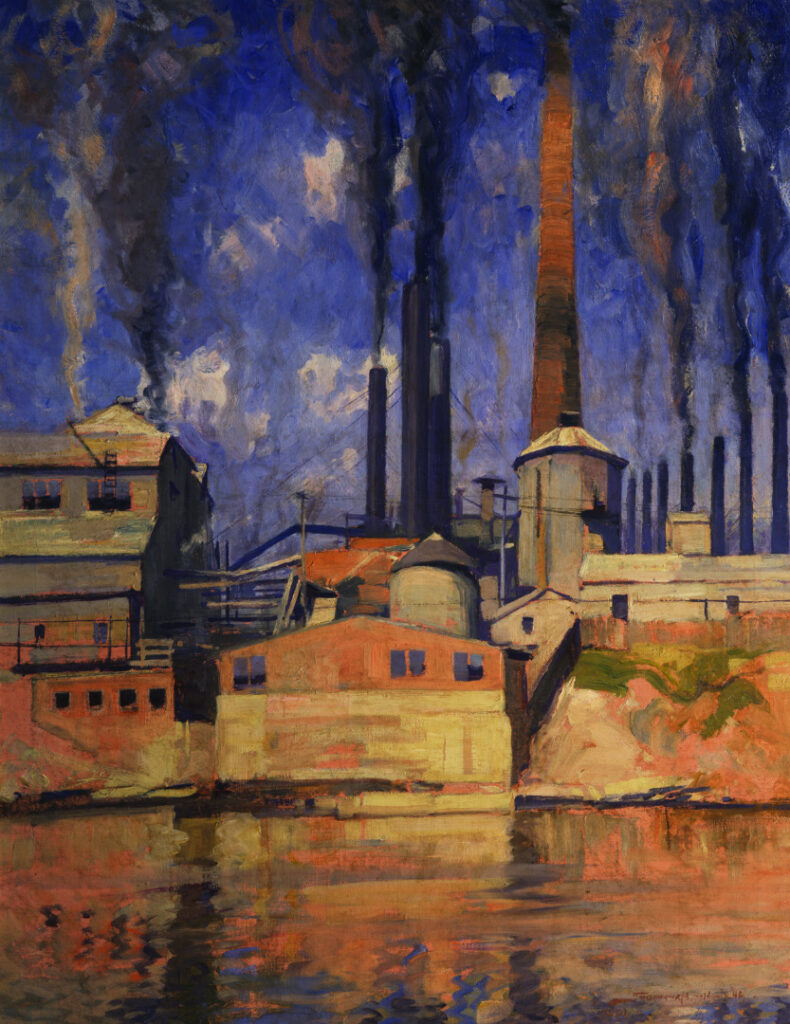
Titled ‘Progress and Its Problems’, the case’s introductory text explains to the visitor why our immediate reaction to a painting of smokestacks is not necessarily what the viewer in 1920 would have thought.
For many, the factory’s billowing smokestack was a powerful symbol of progress, a testament to humanity’s power to harness nature to its own aims. But some observers, chemists among them, realized that there was a price to be paid for rapid industrialization and urbanization. They pointed to a darker side of scientific progress, in which unchecked progress led to unanticipated and unwanted consequences.
As with much of the museum, the overall design of this case helps to evoke the message. To the left of the painting are ascending and highly positive symbols of scientific progress from the early twentieth century such as scientific-achievement medals, a promotional book about Bakelite, and A Cressy Morrison’s Man in a Chemical World. On the right side of the painting, the highest point of the case, is Rachel Carson’s Silent Spring, which is used as a symbol of the turning point of chemistry in the public eye. The artefacts from this point physically descend and include items such as a lead pipe removed from a home in Philadelphia, Kool-Aid packets which contained Red Dye Number 2, and an old can of Crisco. The ‘people’ rail in this section further emphasises the sometimes double-edged nature of progress by featuring Fritz Haber who is referenced as chemistry’s ‘Dr Jekyll and Mr Hyde’.[12]
Coming into its own
https://dx.doi.org/10.15180/170811/011When the museum opened on 3 October 2008, CHF was not sure what to expect; the organisation had planned for developing the museum but had not necessarily planned for what came after it opened. When the project began the measurable outcomes for what success would be – such as visitation numbers – had not been set. While the curatorial team felt optimistic that the general public would find the museum interesting, no one was sure if visitors would come on their own initiative, despite the fact that admission is free. However, opening night, which was on First Friday in Old City Philadelphia – a monthly occurrence where local galleries, museums and shops stay open late to accommodate the after-work crowd – saw the museum greet over 450 visitors. The event had received press coverage and CHF had marketed to local media outlets but the real surprise was the following week when, with opening hours of ten to four o’clock, the museum saw 104 visitors. From October to December of 2008, the museum greeted 1,591 walk-in visitors – far more than anyone at CHF had anticipated. The Museum at CHF had come to life and was generating interest and attendance.
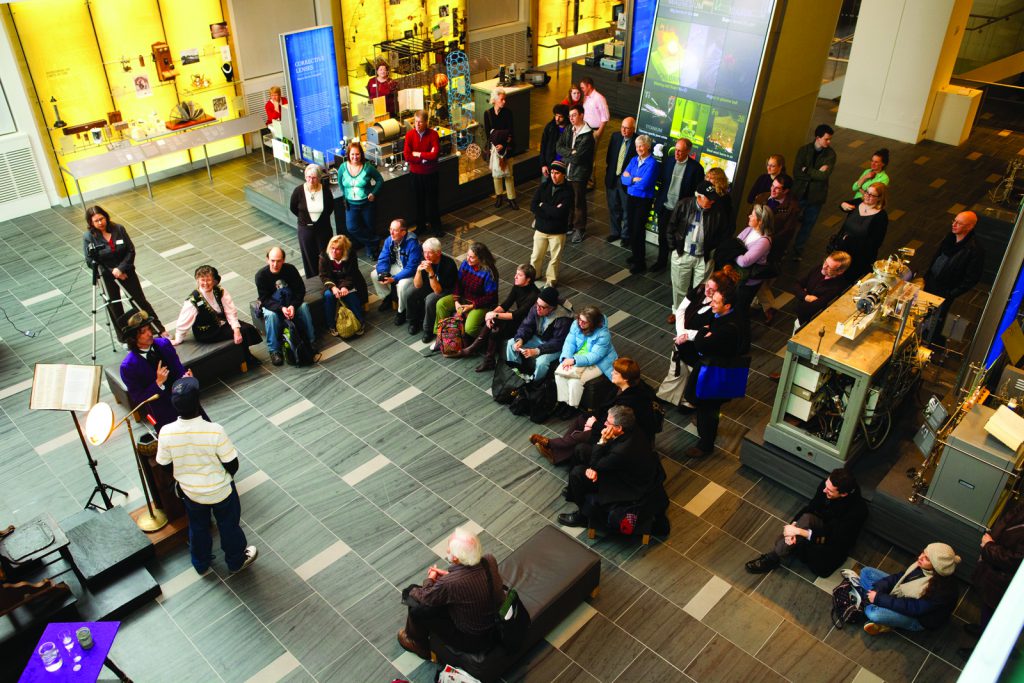
October 2008 was not necessarily the best time to open a new conference centre and museum. Looking back at the 2005 exhibition planning report, one of the assumptions listed was that the core planning team would go out of existence in 2008 and this did come to pass. However, no budgeting or planning had been recommended for personnel and educational programming once the museum opened. CHF had built a museum and now curatorial staff that remained had to implement systems and policies to actually operate it. Budget cuts made conducting evaluations and assessments unattainable. However, informal visitor surveys and a guest book for visitors provided valuable feedback during the first several years of operation. The graduate museum studies program at the University of the Arts in Philadelphia has an annual course on museum evaluation and student project-based evaluations of visitors also helped inform CHF about the museum’s impact.
As a result of early feedback about the limited hours of operation, CHF made First Friday its first official ongoing museum program. On the first Friday of the month, CHF stays open until eight o’clock and provides a special program for the evening. The programs range from informal lectures and demonstrations about the current temporary exhibition to beer sampling sessions to a chemistry-themed radio play. Relatively low-cost, the program has been very successful with attendance averaging 150 visitors during the course of an evening, and with many Fridays surpassing the 200 mark. CHF received a small grant for the 2010 First Friday program which included funding for an evaluation of the program. The evaluation revealed that CHF’s goals were being achieved, as the evaluator summarised: ‘Visitors often stumbled upon the programs but were delighted by their interdisciplinary nature, the interactive formats, and CHF’s ability to make science accessible to the non-scientist.’[13]
There was almost an expectation by the curatorial team for there to be negative comments because of the poor public perception of chemistry and the high level of sensitivity our core constituents had to that negativity. Surprisingly, very few negative comments in terms of the subject itself were received. The first temporary exhibition that CHF hosted/co-developed was called Molecules that Matter, a blended contemporary art/history exhibition which looked at ten molecules discovered in the twentieth century that fundamentally changed our world.[14] DDT was one of the featured molecules and the museum heard from a select number of older chemists about how wrong it was for DDT to be vilified (the negative consequences were discussed in the exhibition, but objectively and not in a way that lay blame on anyone specifically). Overwhelmingly, visitors greeted the subject with enthusiasm and a level of surprise at how the permanent exhibition was interdisciplinary in approach and revealed why the history of chemistry was relevant.
Two consistent negative remarks received during the first year were that the lobby was somewhat intimidating upon entry (it had a rather a ‘corporate-headquarters’ design), and that the artefact labels, which are on the reader rails, were difficult to match with the artefacts they were describing. As a result of this feedback, the lobby was redesigned to include comfortable seating and the reflective film on the glass front doors was removed to make the building more approachable. CHF also added outdoor signage about the museum to help encourage visitors to come in – a simple sandwich board sign on the sidewalk makes a huge difference in the number of visitors. The artefact numbering system received a redesign and now includes a diagram of each case on the reader rail that is number-keyed to the appropriate artefact label.
In 2009, CHF greeted 5,097 walk-in visitors, 623 guests on prearranged tours and 3,033 attendees at events (including First Fridays). The highest attendance year to date was 2012, with a total of 22,406 visitors, including 7,379 walk-in visitors and 1,157 on tours. First Fridays and other events tend to be a predominately local audience while those visiting during regular open hours are often from other parts of the United States or international. A 2009 evaluation of 89 visitors revealed that 37 per cent were from a part of the United States outside of the East Coast and 17 per cent were international visitors (Bachrach, Duguid and Hammell, 2009). The comments left by visitors are overwhelmingly positive and indicate that the approach for the museum was a good decision. Comments from the guest book include:
Great display! – Paul, England
I never dreamed that among the historical treasures of Philadelphia I would find this rare jewel. I am simply awed by the beauty of the displays; material so enchantingly presented it has quickened my pulse. – visitor, Iowa
This is by far the coolest thing I’ve seen in Philly. – KB
Enjoyed exhibits immensely – as an artist, designer and a ‘science geek.’ Beautiful displays full of accessible and fascinating information. – MaryRose, Philadelphia
What a great place – I love the way the exhibits make complicated science intelligible and accessible for those of us who only took one high school chemistry course many years ago! I’m also delighted by the way rare books and art are integrated into all of the exhibits. – Anonymous
To every season
https://dx.doi.org/10.15180/170811/012The process of developing a permanent exhibition about the history of chemistry was, at times, a challenging one, but for those involved in the experience it was also a once-in-a-lifetime opportunity to build a new museum on a topic that few science museums are currently able to focus on. In 2013, CHF prepared for its third leadership transition and the fifth anniversary of the museum by taking some time to reflect. Working with nationally recognised museum planning and evaluation firm Randi Korn and Associates, CHF staff gathered to assess what was working and how to maximize the impact of the museum. All museums have limited resources and the staff at CHF wanted to be sure that we were maximising impact. What was exciting to see at this series of cross-departmental planning sessions was how positive staff felt about the museum and how the museum had become an essential part of the organisation overall. As a result of this exercise, CHF identified the impact/goal of the museum as: ‘CHF’s exhibitions, programs, and artifacts inspire visitors to explore chemistry’s history and value its significance in everyday life.’ The take-away after five years was that, while programs and exhibitions could look at science topics broadly, at its core the focus of the museum should be about chemistry because that is what makes CHF unique and where it can make the most significant impact.
As the CHF museum moves towards its tenth anniversary, the organisation and staff continue to explore ways to further the impact articulated during the impact planning exercise. The temporary exhibition program is particularly robust and is used to engage a variety of audiences. Museum staff are exploring how new media technologies could be used to add content and layers of access to the visitor’s experience. The year 2014 saw a slight decline in attendance, with 9,955 walk-in visitors, 1,127 on tours, and 1,450 attending special events. In response, the museum introduced weekend hours during the spring and summer of 2015 to further increase accessibility. The results were not only increased visitation numbers, but more importantly, an increase in local and regional visitors, 44 per cent of weekend visitors are local as opposed to 37 per cent during the week. This is a target audience for the museum because a more local audience tends to become more engaged with the organisation and participate in more programs. Innovative programming, including hands-on activities with an education collection of historic artefacts, continues to be tried and refined and CHF is becoming increasingly involved with partner institutions throughout the city. Although there were concerns as the museum was being planned of the institution receiving negative feedback or publicity by opening its doors to a broader audience because of negative attitudes about chemistry, the opposite has occurred. By opening and becoming more transparent and welcoming, CHF has found an enthusiastic public eager to learn about the history of science and engage with chemistry-related topics. The growth and maturation will continue but satisfaction is felt knowing that the goal to reach an adult but public audience with a message of how the history of science, and chemistry especially, has impacted the modern world is being enthusiastically received.
Acknowledgements
My thanks to the Artefacts conference and colleagues that provided valuable feedback and encouragement as the museum at CHF took shape and matured. The curatorial team for developing the museum at CHF was an exceptional group of colleagues who pulled together, faced adversity, and had the commitment to make a great museum – Mary Ellen Bowden, David Brock, Rosie Cook, Marge Gapp, Laura Igoe, Andrew Mangravite, Erin McLeary, Cyrus Mody, Gigi Naglak, Patrick Shea, Amanda Shields, Jody Roberts – it was an honour to work with you. Thank you to Shelley Wilks Geehr for championing the museum through its infant and toddler years. And a special thanks to my husband, Gene, and son, Lucas, for enduring an often-absent wife and mother and cheering me on to the finish line.
Tags
Footnotes
Back to text
Back to text
Back to text
Back to text
Back to text
Back to text
Back to text
Back to text
Back to text
Back to text
Back to text
Back to text
Back to text
Back to text


